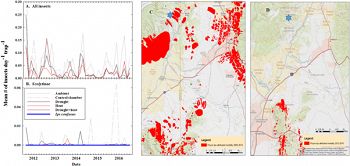McDowell et al., 2019
Mechanisms of a coniferous woodland persistence under drought and heat
McDowell N.G., Grossiord C., Adams H.D., Pinzón-Navarro S., Mackay D.S., Breshears D.D., Allen C.D., Borrego I., Dickman L.T., Collins A., Gaylord M., McBranch N., Pockman W.T., Vilagrosa A., Aukema B., Goodsman D., and Xu C. (2019)
Environmental Research Letters 14(4): 045014
-
Catalina-Jemez, INVESTIGATOR
-
Catalina-Jemez, INVESTIGATOR
Abstract
Refugia from insect attack promotes resiliency to drought and heat. Left-hand column shows observations of trapped insects from the experimental site. (A) All insects show that a large number of insects were trapped at this site. In contrast, (B) Scolytinae were rarely observed in any treatments. The insects that kill piñon pine, namely Ips confusus, were never observed (blue line in panel B). (C), (D) aerially-detected piñon pine mortality attributed to Ips confusus from 2000–2016 (panel C) from 2012–2016 (panel D). The field site is shown in with a blue star near the top of the map.
Predictions of warmer droughts causing increasing forest mortality are becoming abundant, yet few studies have investigated the mechanisms of forest persistence. To examine the resistance of forests to warmer droughts, we used a five-year precipitation reduction (~45% removal), heat (+4 °C above ambient) and combined drought and heat experiment in an isolated stand of mature Pinus edulis-Juniperus monosperma. Despite severe experimental drought and heating, no trees died, and we observed only minor evidence of hydraulic failure or carbon starvation. Two mechanisms promoting survival were supported. First, access to bedrock water, or 'hydraulic refugia' aided trees in their resistance to the experimental conditions. Second, the isolation of this stand amongst a landscape of dead trees precluded ingress by Ips confusus, frequently the ultimate biotic mortality agent of piñon. These combined abiotic and biotic landscape-scale processes can moderate the impacts of future droughts on tree mortality by enabling tree avoidance of hydraulic failure, carbon starvation, and exposure to attacking abiotic agents.
Citation
McDowell N.G., Grossiord C., Adams H.D., Pinzón-Navarro S., Mackay D.S., Breshears D.D., Allen C.D., Borrego I., Dickman L.T., Collins A., Gaylord M., McBranch N., Pockman W.T., Vilagrosa A., Aukema B., Goodsman D., and Xu C. (2019): Mechanisms of a coniferous woodland persistence under drought and heat. Environmental Research Letters 14(4): 045014 . DOI: 10.1088/1748-9326/ab0921
 This Paper/Book acknowledges NSF CZO grant support.
This Paper/Book acknowledges NSF CZO grant support.
Explore Further


